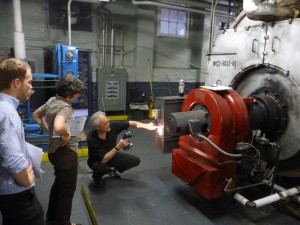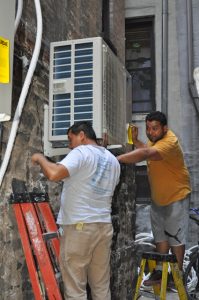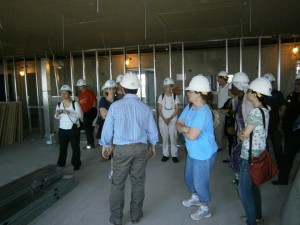 Tom Sahagian knows there’s no time left to dawdle in controlling the greenhouse gas (GHG) emissions from New York City’s buildings. The problem: There’s a shortage of people with the right skills to do it. Sahagian is not talking about policy wonks. “The life of the mind is not what’s going to get us to solving the climate crisis. Pontificating doesn’t do it. You need people who can actually physically do what’s required.”
Sahagian, a GreenhomeNYC board member with many years of experience as an energy efficiency consultant, believes that to dramatically decrease building-generated GHGs, the city’s buildings will have to be powered with clean electricity (e.g. wind or solar) rather than fossil fuels.
An Electrifying Challenge
“New York City needs to convert a thousand buildings a year for the next 30 years,” he says, “which will take hard work and coordination and commitment—and contractors and workers with the right skills. And right now, we have a shortage of those people.”
According to the Urban Green Council, buildings account for nearly 70% of New York City’s energy use (much higher than the national average). City regulations require large buildings to reduce GHG emissions by 40% by 2030.To reduce GHGs, we can reduce building energy demand (through insulation, better glazing, air leak reduction, efficient lighting) or we can replace power from fossil fuels with clean electricity. Only electrification has the potential to largely eliminate building-related GHGs.
Perhaps surprisingly, Sahagian says that the city’s many glass towers are not the primary target for electrification. Those buildings use energy primarily for cooling, and that cooling is usually already electricity dependent. They will generate fewer GHGs as the electric grid becomes greener.
Pump up the Volume
The primary way to electrify existing building stock, according to Sahagian, is to install heat pumps; they allow use of cleaner power, and are significantly more energy efficient than fossil-fuel powered boilers. Installing them will require contractors and workers with specialized skills. They must be able to properly locate and mount the units inside and outside the building, size them correctly, and integrate the heat pump and building wiring.
What’s a Heat Pump, Anyway?
Tom Sahagian knows there’s no time left to dawdle in controlling the greenhouse gas (GHG) emissions from New York City’s buildings. The problem: There’s a shortage of people with the right skills to do it. Sahagian is not talking about policy wonks. “The life of the mind is not what’s going to get us to solving the climate crisis. Pontificating doesn’t do it. You need people who can actually physically do what’s required.”
Sahagian, a GreenhomeNYC board member with many years of experience as an energy efficiency consultant, believes that to dramatically decrease building-generated GHGs, the city’s buildings will have to be powered with clean electricity (e.g. wind or solar) rather than fossil fuels.
An Electrifying Challenge
“New York City needs to convert a thousand buildings a year for the next 30 years,” he says, “which will take hard work and coordination and commitment—and contractors and workers with the right skills. And right now, we have a shortage of those people.”
According to the Urban Green Council, buildings account for nearly 70% of New York City’s energy use (much higher than the national average). City regulations require large buildings to reduce GHG emissions by 40% by 2030.To reduce GHGs, we can reduce building energy demand (through insulation, better glazing, air leak reduction, efficient lighting) or we can replace power from fossil fuels with clean electricity. Only electrification has the potential to largely eliminate building-related GHGs.
Perhaps surprisingly, Sahagian says that the city’s many glass towers are not the primary target for electrification. Those buildings use energy primarily for cooling, and that cooling is usually already electricity dependent. They will generate fewer GHGs as the electric grid becomes greener.
Pump up the Volume
The primary way to electrify existing building stock, according to Sahagian, is to install heat pumps; they allow use of cleaner power, and are significantly more energy efficient than fossil-fuel powered boilers. Installing them will require contractors and workers with specialized skills. They must be able to properly locate and mount the units inside and outside the building, size them correctly, and integrate the heat pump and building wiring.
What’s a Heat Pump, Anyway?
 Heat pumps use a compression cycle to move existing heat energy between locations—as with refrigerators and air conditioners. They can be used to heat or cool a space. Even when the air outside is cold, it still contains heat energy (when it’s 30 degrees outside it’s still more than 489 degrees Fahrenheit above absolute zero). Today’s heat pumps can extract heat from air down to about 13 degrees Fahrenheit. Heat pumps can use an air or ground source; air source heat pumps are simpler and less expensive to install.
Building the Skill Pool
“There are simply not enough people with the needed skills,” says Sahagian. “I’ve been trying to bid out electrification projects, and some of the bids I get back are much higher than they should be. Demand for those skills is significantly higher than supply. We need quality contractors who can do a job for a reasonable price,” he emphasizes, “or we will end up with a lot of refrigerant leaks that will negate the value of the conversions.”
Several approaches can help in building a pool of people with the right skills. Sahagian notes, “There are people out there who don’t know that they would be interested in this kind of work. If they are exposed to it, some of them will discover an interest. If they like to take things apart and reassemble them, if they have curiosity, commitment, intelligence, and a willingness to work hard, that’s what we need.” High school vocational training could raise awareness of and interest in the field. Once interested, high school graduates could, for example, pursue a specialized two-year degree—once those programs exist.
Heat pumps use a compression cycle to move existing heat energy between locations—as with refrigerators and air conditioners. They can be used to heat or cool a space. Even when the air outside is cold, it still contains heat energy (when it’s 30 degrees outside it’s still more than 489 degrees Fahrenheit above absolute zero). Today’s heat pumps can extract heat from air down to about 13 degrees Fahrenheit. Heat pumps can use an air or ground source; air source heat pumps are simpler and less expensive to install.
Building the Skill Pool
“There are simply not enough people with the needed skills,” says Sahagian. “I’ve been trying to bid out electrification projects, and some of the bids I get back are much higher than they should be. Demand for those skills is significantly higher than supply. We need quality contractors who can do a job for a reasonable price,” he emphasizes, “or we will end up with a lot of refrigerant leaks that will negate the value of the conversions.”
Several approaches can help in building a pool of people with the right skills. Sahagian notes, “There are people out there who don’t know that they would be interested in this kind of work. If they are exposed to it, some of them will discover an interest. If they like to take things apart and reassemble them, if they have curiosity, commitment, intelligence, and a willingness to work hard, that’s what we need.” High school vocational training could raise awareness of and interest in the field. Once interested, high school graduates could, for example, pursue a specialized two-year degree—once those programs exist.
 Sahagian says, “We need to do everything we can to raise the social standing of the people who can accomplish this for us. There’s a huge amount of creativity involved in solving the problems this kind of work entails, and it’s underappreciated.”
“We need government incentives for people to consider pursuing green jobs. People who learned HVAC as students could be helpers to heat pump conversion teams, and that would be very valuable— to them, their employers, and to the country.” The important thing, Sahagian emphasizes, is to get people trained and working on heat pump conversions—now.
Sahagian says, “We need to do everything we can to raise the social standing of the people who can accomplish this for us. There’s a huge amount of creativity involved in solving the problems this kind of work entails, and it’s underappreciated.”
“We need government incentives for people to consider pursuing green jobs. People who learned HVAC as students could be helpers to heat pump conversion teams, and that would be very valuable— to them, their employers, and to the country.” The important thing, Sahagian emphasizes, is to get people trained and working on heat pump conversions—now.
Learn more about hands-on job opportunities at our July 7 GreenHomeNYC online Careers event. Get more information and register here.
